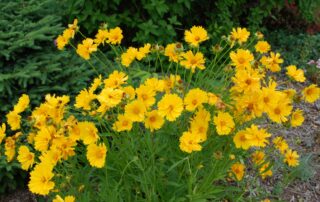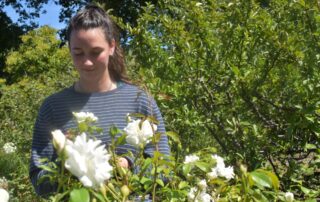 Pillar: Little Portion
Pillar: Little Portion
Laudato Si’ Action Plan Goals: Cry of the Poor and Ecological Spirituality
 Pillar: Little Portion
Pillar: Little Portion
Laudato Si’ Action Plan Goals: Cry of the Poor and Ecological Spirituality
Group (Grade Levels): 3-8; may be scaled for different age groups, including adults
Learning Goals:
- Practice observing plants or flowers and becoming aware of your responses to them.
- Learn how to experience beauty in your local place.
- Experience writing poetry as a form of self-expression, in the mystery of “little portion.”
- Learn how to write poetry as an expression of beauty.
Materials Needed: a flowering plant, ideally outdoors, and/or a fruiting plant. Lined paper for drafts, plain paper for final. Writing utensils and coloring materials at the leader’s discretion.
Estimated Time to Complete Activity: about 1 1/2 hours
General Outline of Experience
-
- It is good to give thanks to God for the beauty of creation and to spend time with Him reflecting on His works. Let our expressions of beauty through poetry reflect the beauty of God revealed in all of His works.
- Read the following quotation and discuss
- Laudato Si’, n. 12: “What is more, Saint Francis, faithful to Scripture, invites us to see nature as a magnificent book in which God speaks to us and grants us a glimpse of his infinite beauty and goodness. ‘Through the greatness and the beauty of creatures one comes to know by analogy their maker’ (Wis 13:5) . . . For this reason, Francis asked that part of the friary garden always be left untouched, so that wild flowers and herbs could grow there, and those who saw them could raise their minds to God, the Creator of such beauty.”
- Possible discussion questions
- What particular memories of flowers do you have, and why are the memories special to you?
- What is your favorite flower? Why?
- What analogies do flowers bring to mind for you? Do any of them relate to God? (An analogy is a comparison between two things that have some similarity, at least in certain aspects. Analogies are usually made to help explain a point or bring about a deeper understanding of the things being compared.)
- Close with a prayer.
Observation
-
- Leader will prompt participants to remember curriculum regarding parts of flowers and their functions.
- Participants will be given a certain area in which they can roam, inspect, and choose a particular plant or flower. They should spread out to encourage independent reflection and work.
- As they observe the plant, participants will write down relevant words that describe the scene using all five senses. Encourage participants to take into account the weather, animals, and their own feelings.
-
- The group will gather within earshot for the next instruction. Leader will share examples of finished poems having to do with creation appropriate for the grade level. Group will note the syllables, word count, and rhyming patterns to this particular poem. Leader will prompt participants to identify the emotional themes expressed through the images of the poem, i.e., sadness, hope, wonder.
- A helpful resource for poems for Catholic children is the Nature Poems for Catholic Children series, by Janet P. McKenzie, OCDS.
- Some poets whose poems on nature are a good resource include:
- Catholic poets: St. Francis of Assisi, St. Hildegard of Bingen, Gerard Manley Hopkins, Joyce Kilmer, Richard Crashaw
- Other poets with significant nature poems: Robert Frost, Emily Dickinson, John Keats, William Wordsworth, Ralph Waldo Emerson
- Lead up to key point: Flowers have a specific function in the life of a plant and in the greater ecosystem. (For example, they provide nectar for bees and certain insects and birds, and food and cover for grazing animals. When fertilized, their flowers become fruits that carry seeds for reproduction and also provide food for animals.) Yet flowers are not only functional, they are also beautiful and sometimes extravagantly so. The enjoyment of beauty does not require an entrance fee or expensive travel; it is all around us. Think of all the beauty around your home or in your local place.
- The beauty of creation is a gift from God, and it belongs to everyone. God communicates something of himself through His creation. Appreciating and reflecting upon true beauty brings us closer to God and to each other.
- Transition: As we write poetry today let us contemplate the shared appreciation of beauty experienced by each person in a unique way.
- The group will gather within earshot for the next instruction. Leader will share examples of finished poems having to do with creation appropriate for the grade level. Group will note the syllables, word count, and rhyming patterns to this particular poem. Leader will prompt participants to identify the emotional themes expressed through the images of the poem, i.e., sadness, hope, wonder.
Writing a Poem
-
- The participants will disperse again to write.
- Participants will use their words from the Observation stage to formulate a poem.
- Advanced participants can be encouraged to write multiple poems with contrasting themes.
- Once the draft is complete, participants will neatly write their poems on blank paper.
- They can draw a picture or border with their poems.
Sharing and Presenting Poetry
-
- The group will gather once more in an area that is comfortable to sit.
- Drinks and snacks could be part of a short break.
- Each person will stand and read his or her poem. The group will listen respectfully and applaud (or snap) at the conclusion of each recitation.
- If time allows. . . A discussion reflecting on the poems shared:
- What are themes and words that many have in common?
- What words or themes are unique?
- How did each participant express him or herself in each poem?
- How might culture, religion, and life experiences affect the themes of the poem?
- The group will gather once more in an area that is comfortable to sit.
-
- Read and discuss one of the quotations from the supplementary section.
- Discuss or spend time journaling on the personal process of writing the poem.
- What was the hardest part about observing, meditating, and writing?
- In what everyday things, people, and places do you see beauty?
- What does my poem reveal about me? What does it reveal about God?
- What analogies were used in the poems?
- Consider also the following quotations for gathering or integration time:
- “Why are you anxious about clothes? Learn from the way the wildflowers grow. They do not work or spin. But I tell you that not even Solomon in all his splendor was clothed like one of them” (Matthew 6: 28-29).
- “The earth brought forth vegetation, plants yielding seed after their kind, and trees bearing fruit with seed in them, after their kind; and God saw that it was good” (Genesis 1:12).
- “My heart overflows with noble words. To the king I address the song I have made, my tongue as nimble as the pen of a scribe” (Psalm 45:2).




